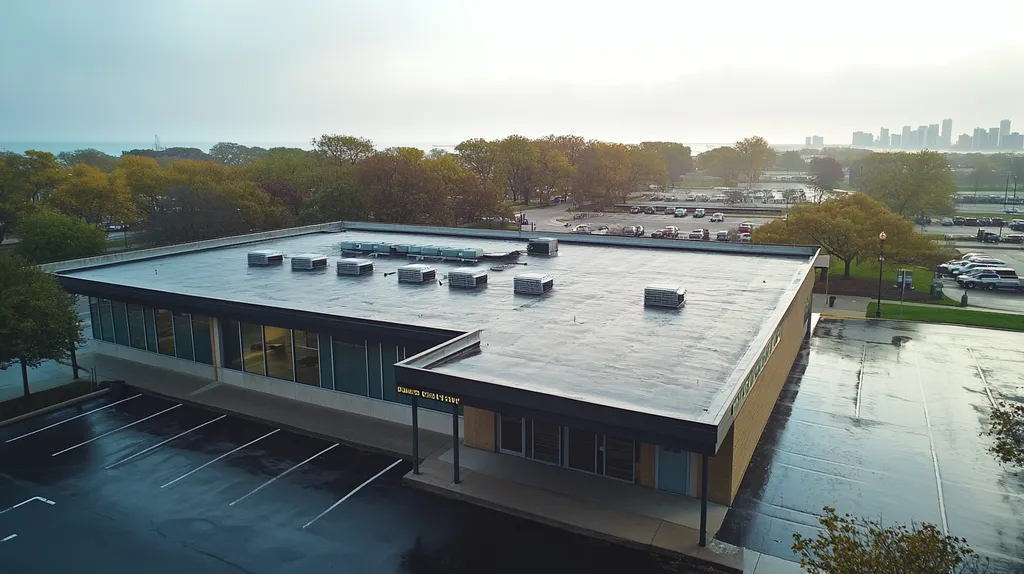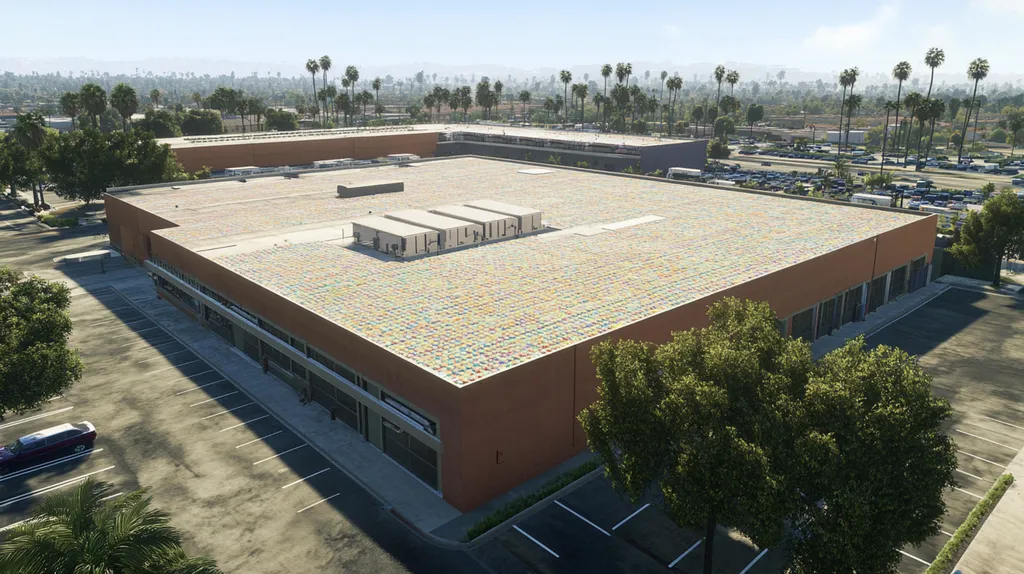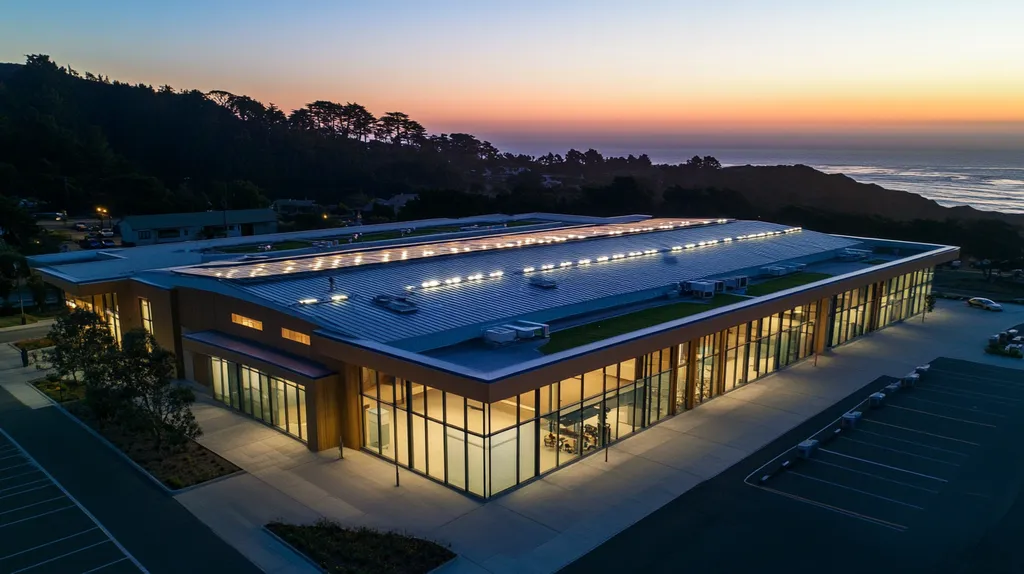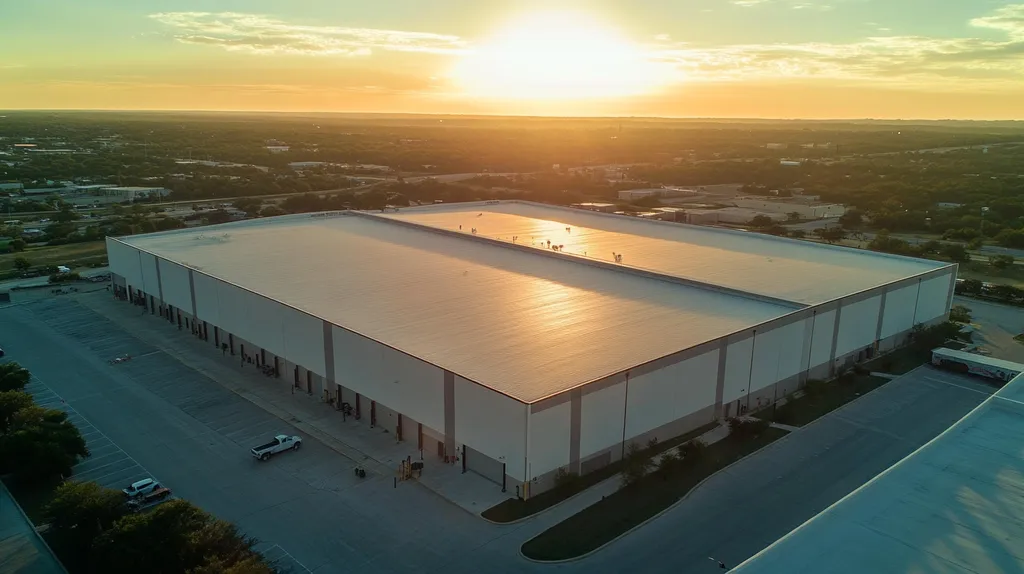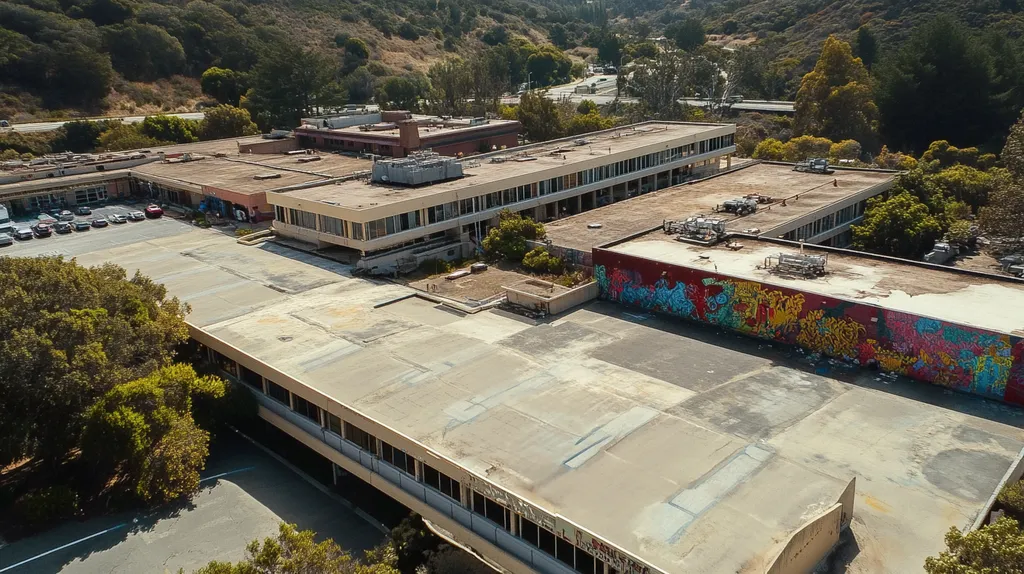Commercial property managers lose millions annually by incorrectly timing roof repairs, with rushed summer projects costing up to 300% more than strategically scheduled maintenance.
The conventional wisdom about seasonal roofing restrictions no longer applies to modern commercial systems, yet outdated assumptions continue driving costly maintenance decisions.
Understanding the true impact of seasonal conditions on roofing materials, contractor availability, and project costs has become essential for protecting both buildings and budgets in today’s complex facility management landscape.
SECTION 1: COMMON MISCONCEPTIONS
When it comes to commercial roof repairs, timing can mean the difference between a minor fix and a major replacement. Property managers often operate under outdated assumptions about seasonal restrictions, leading to delayed maintenance and escalating costs. Understanding when repairs can be performed effectively is crucial for protecting both the building and its occupants.
Myth: Roof Repairs Are Best Left for Summer Only
Many facility managers automatically default to scheduling roof repairs during summer months, creating unnecessary backlogs and delays. This practice stems from outdated notions about material limitations and worker safety that no longer apply to modern roofing systems.
Fall actually presents ideal conditions for many types of commercial roof repairs, offering cooler temperatures and reduced risks of extreme weather events. The moderate climate allows materials to cure properly while providing comfortable working conditions for crews.
Spring offers similar advantages, with the added benefit of addressing any damage sustained during winter months before it can worsen. Additionally, scheduling flexibility increases during these shoulder seasons when contractor availability is higher.
These expanded timeframes for repairs can lead to significant cost savings and more thorough maintenance programs. (source: Roof Crafters)
Misunderstanding Impact of Weather Variability on Roofing
Weather patterns affect different roofing materials and repair techniques in distinct ways. Understanding these relationships helps property managers make informed decisions about timing repairs.
High temperatures can actually complicate certain repairs by making materials too pliable or causing rapid curing. Moderate temperatures often provide better working conditions and more predictable material behavior.
Humidity levels, not just temperature, play a crucial role in repair success. Many modern roofing systems perform well in a range of moisture conditions, expanding the viable repair window.
Wind patterns and precipitation forecasts should guide scheduling more than calendar dates. This approach ensures optimal conditions for specific repair types while maintaining building protection.
False Belief That Winter Roof Repairs Are Impossible
Modern roofing technologies and techniques have revolutionized winter repair capabilities. Cold-weather adhesives and specialized equipment now allow for effective repairs even in sub-freezing temperatures.
Emergency repairs can and should be addressed immediately, regardless of season. Postponing urgent repairs due to winter conditions often leads to more extensive damage and higher costs.
Many roofing contractors maintain dedicated cold-weather crews trained in winter-specific techniques. These teams use specialized equipment and modified procedures to ensure repair quality.
Winter repairs can actually benefit from reduced business disruption and potentially lower costs due to seasonal contractor availability. Strategic scheduling during colder months can maximize both repair effectiveness and budget efficiency.
SECTION 2: PRACTICAL IMPLICATIONS
Strategic timing of commercial roof repairs can mean the difference between a lasting solution and recurring problems. Studies show that poorly timed repairs cost property managers up to 65% more in the long run due to material failures and accelerated deterioration. Beyond immediate repair costs, the timing of roofing work directly impacts building operations, tenant satisfaction, and long-term maintenance budgets.
Seasonal Weather Effects on Roofing Material Performance
Commercial roofing materials respond differently to seasonal temperature variations, with most systems performing optimally during moderate weather conditions. Extreme heat can cause membrane materials to become overly pliable, while severe cold can lead to brittleness and cracking.
Fall is particularly advantageous for roof repairs due to stable temperatures and mild weather patterns that allow materials to cure properly. These conditions minimize the risk of thermal shock and provide ideal circumstances for adhesive application and material handling. (source: Tema Roofing Services)
Moisture levels significantly influence repair success rates. High humidity can interfere with proper adhesion, while excessive dryness may affect material flexibility and workability.
UV exposure also plays a crucial role in material performance. Moderate sun exposure during repair work helps activate certain adhesives without causing the extreme heat-related issues common in peak summer months.
Scheduling Roof Repairs to Minimize Operational Disruption
Effective scheduling requires balancing urgent repair needs with tenant comfort and business operations. Smart timing can reduce disruption by up to 40% compared to emergency or poorly timed repairs.
Early morning or evening repair windows often provide the best compromise between worker safety and minimal business impact. These periods typically offer cooler temperatures while avoiding peak business hours.
Phased repair approaches allow buildings to maintain partial operational capacity during extensive work. This strategy helps maintain tenant satisfaction while ensuring thorough completion of necessary repairs.
Coordinating repairs with other scheduled maintenance activities can reduce overall downtime and maximize efficiency. This approach also helps minimize the frequency of access disruptions to sensitive areas.
Impact of Contractor Availability Across Seasons
Contractor demand fluctuates predictably throughout the year, affecting both scheduling flexibility and pricing. Peak season often brings extended wait times and premium pricing due to high demand.
Off-peak scheduling can result in cost savings of 15-25% through reduced labor rates and more competitive bidding. These periods also typically offer greater flexibility in project timing and execution.
Weather-related delays become less frequent during moderate seasons, allowing for more reliable project completion timelines. This predictability helps property managers maintain more accurate maintenance schedules.
Building relationships with multiple qualified contractors ensures access to expertise across different seasonal conditions. This network approach provides backup options and specialized capabilities when needed.
SECTION 3: COST OF MISINFORMATION
The financial impact of misunderstanding commercial roof repair timing extends far beyond immediate repair costs. Industry data shows that postponing repairs to “preferred” seasons can increase total project costs by up to 300% when emergency interventions become necessary. This misconception about optimal repair timing creates a cascade of preventable expenses that affect both operational budgets and long-term asset value.
Financial Risks of Ignoring Optimal Roofing Seasons
Early spring scheduling offers significant cost advantages through reduced contractor wait times and optimal working conditions. Property managers who leverage these timing advantages often secure better pricing and more flexible scheduling options.
Postponing repairs until peak summer season typically results in premium pricing due to high demand and extended project timelines. These delays can increase project costs by 25-40% compared to early spring repairs.
The compounding effect of delayed maintenance creates a snowball effect of deterioration. What begins as a minor repair can escalate into a full system replacement when optimal repair windows are missed.
Smart scheduling during early spring through late fall maximizes both repair effectiveness and cost efficiency. (source: MacDermott Roofing)
Cost Implications of Emergency Repairs Due to Poor Timing
Emergency repair scenarios typically command premium pricing, often 200-300% higher than scheduled maintenance. These inflated costs stem from urgent mobilization requirements and after-hours labor rates.
Business disruption costs multiply when emergency repairs force unexpected shutdowns or relocations. These indirect expenses often exceed the actual repair costs by affecting productivity, inventory, and customer relationships.
Insurance claims resulting from emergency situations frequently carry higher deductibles and may impact future premium rates. This creates a double financial burden for property managers.
Emergency repairs also tend to be temporary solutions, requiring follow-up permanent repairs that further increase total project costs. This cycle of temporary fixes compounds the financial impact.
Hidden Expenses from Weather-Related Project Delays
Weather delays extend project timelines and increase labor costs through multiple mobilizations and demobilizations. Each interruption adds setup and breakdown time that wasn’t factored into original estimates.
Material costs often surge when weather delays force contractors to store and protect partially completed work. Additional weatherproofing measures and potential material replacement add unexpected expenses.
Extended project timelines increase overhead costs through prolonged equipment rentals and site security requirements. These carrying costs can significantly impact project budgets.
Tenant complaints and potential lease violations may arise from extended repair periods, creating additional financial exposure through rent abatements or lease terminations.
SECTION 4: REALITY CHECK
Modern commercial roofing demands precise timing and planning for optimal repairs. Industry data shows that 85% of premature roof failures stem from poor maintenance timing and rushed repairs during non-ideal conditions. While conventional wisdom suggests any mild day is suitable for repairs, the reality involves complex interactions between temperature, humidity, material chemistry, and regional weather patterns that determine repair success.
Spring and Fall as Ideal Seasons for Roof Repairs
Temperature stability during spring and fall creates optimal conditions for most commercial roofing materials. These seasons typically maintain the 50-75°F range needed for proper adhesive curing and material flexibility without the extreme fluctuations that compromise repair integrity.
Moderate humidity levels in these seasons support proper membrane bonding and reduce moisture-related complications. This natural advantage minimizes the need for additional moisture control measures, streamlining the repair process.
Daylight hours during these seasons provide adequate working time without the intense UV exposure of summer. This balance allows crews to maintain productivity while avoiding heat-related material complications.
Lower wind conditions typical of these seasons also enhance worker safety and improve application precision. These factors combine to create the most reliable environment for lasting repairs.
Overcoming Weather Challenges in Off-Peak Seasons
Summer repairs face unique challenges from extreme heat that can compromise material integrity. Surface temperatures on commercial roofs can exceed 175°F, making proper adhesive application nearly impossible and creating dangerous working conditions.
Winter repairs require specialized cold-weather materials and techniques that increase costs by 30-50%. Even with these adaptations, freezing temperatures can prevent proper material bonding and create hidden vulnerabilities.
Moisture management becomes critical during off-peak seasons. Dew point calculations and moisture meters must guide daily work schedules to prevent trapped moisture from compromising repairs.
Advanced weather monitoring systems help contractors identify viable repair windows during challenging seasons. This technology-driven approach maximizes productivity during limited favorable conditions.
Regional Climate Considerations in Scheduling Repairs
Coastal regions face unique challenges from salt air exposure and hurricane seasons that limit optimal repair windows. These areas often require specialized materials and application techniques that perform best during specific seasonal conditions.
Desert climates experience extreme temperature variations that can stress repair materials beyond their design limits. Morning repairs typically offer the best conditions, but timing must account for rapid temperature changes throughout the day.
Northern regions must balance freeze-thaw cycles that can compromise repairs if not properly timed. Understanding these cycles helps property managers schedule work during stable temperature periods.
Mountain environments present altitude-related challenges that affect material behavior and curing times. Higher elevations require adjustments to standard application procedures and timing considerations.
SECTION 5: EVIDENCE-BASED ALTERNATIVES
Strategic material selection and timing can dramatically impact commercial roof performance and longevity. Studies show that 73% of premature roof failures stem from mismatched materials or poor seasonal timing. Yet many property managers continue relying on outdated assumptions about roofing materials and maintenance schedules, leading to accelerated deterioration and inflated costs. Understanding evidence-based alternatives can help facilities teams optimize their roofing investments while ensuring reliable protection.
Selecting Roof Materials Suited for Seasonal Conditions
Different commercial roofing materials exhibit distinct performance characteristics across seasonal conditions. TPO membranes excel in high-temperature environments due to their heat-reflective properties, while EPDM provides superior cold-weather flexibility and thermal stability.
Material selection must account for local climate patterns and seasonal stress factors. High-UV regions require enhanced UV-resistant formulations, while areas with frequent temperature swings need materials with superior thermal cycling resistance.
Modern coating systems can enhance seasonal performance of existing roofs. Reflective coatings reduce summer heat absorption by up to 85%, while specialized winter-grade products maintain flexibility in sub-freezing conditions.
Proper material selection based on seasonal conditions dramatically impacts long-term performance and maintenance requirements. Believing in common commercial roof repair myths about material selection can put both roof integrity and business operations at risk. (source: Rodd Roofing)
Implementing Preventative Maintenance During Mild Weather
Regular inspections during moderate weather conditions allow thorough evaluation of roof conditions without weather-related complications. These assessments should focus on identifying early warning signs of deterioration before they escalate into major issues.
Preventative maintenance tasks like drain clearing, seam inspection, and minor repairs prove most effective during mild weather. These conditions allow proper material curing and adhesion while providing comfortable working conditions for detailed examination.
Documentation during these inspections creates valuable baseline data for tracking roof performance. This information helps identify seasonal stress patterns and guides future maintenance scheduling.
Establishing comprehensive maintenance protocols during favorable weather reduces emergency repair frequency by up to 60%. These programs should include both visual inspections and instrumental testing to detect hidden issues.
Leveraging Off-Peak Seasons for Cost Savings
Strategic scheduling during off-peak seasons can reduce project costs by 15-30%. Lower contractor demand during these periods often translates to more competitive pricing and increased scheduling flexibility.
Weather patterns during shoulder seasons typically provide more consistent working conditions. This stability reduces weather-related delays and helps maintain project timelines.
Off-peak timing allows for more thorough project planning and execution. Contractors can dedicate more attention to detail when not juggling multiple emergency projects.
Material costs often decrease during slower periods as suppliers adjust inventory levels. Taking advantage of these pricing cycles can significantly impact overall project budgets.
SECTION 6: TEST AND VERIFY
Commercial roof performance hinges on rigorous testing and verification protocols that go far beyond casual visual inspections. Industry data shows that buildings implementing comprehensive monitoring programs reduce emergency repairs by 70% and extend roof life by 8-12 years. Yet many property managers rely on outdated assessment methods, missing critical warning signs until water infiltration or structural damage occurs. Modern verification approaches combine advanced diagnostic tools, precise weather data, and contractor accountability measures to optimize repair timing and effectiveness.
Monitoring Roof Condition Year-Round with Inspection Tools
Core monitoring strategies must employ infrared thermography, electronic leak detection, and nuclear moisture testing to identify issues before they become visible problems. These technologies can detect moisture infiltration and insulation deterioration months before traditional inspection methods.
Automated monitoring systems using embedded sensors provide continuous data on membrane stress, drainage performance, and structural movement. This real-time information allows facility managers to address developing issues during optimal repair conditions rather than waiting for failure.
Digital documentation through drone surveys and 3D mapping creates detailed baseline conditions for tracking degradation rates. These tools generate measurable data points that inform repair timing decisions and validate maintenance investments.
Regular core sampling and material testing provide crucial information about system integrity and remaining service life. Understanding these factors helps property managers schedule repairs during ideal seasonal windows rather than reacting to emergencies.
Using Weather Data to Plan Repair Timing Accurately
Advanced weather modeling systems now provide highly accurate 10-day forecasts specifically calibrated for roofing work. These tools analyze temperature ranges, precipitation probability, and wind conditions to identify optimal repair windows.
Historical weather pattern analysis helps predict seasonal transitions and extreme weather risks. This data allows property managers to schedule repairs during traditionally stable periods while avoiding known challenging conditions.
Dew point tracking and humidity forecasting prove essential for preventing moisture-related installation failures. Understanding these atmospheric conditions helps contractors select appropriate materials and application methods for specific weather windows.
Local microclimate data from roof-mounted weather stations provides precise environmental conditions affecting repair timing. This granular information ensures repair conditions meet manufacturer specifications for material performance.
Validating Contractor Claims on Seasonal Suitability
Property managers must require detailed documentation of material temperature limitations and curing requirements. These specifications should align with actual weather conditions during planned repair periods rather than ideal laboratory conditions.
Contractor qualifications should include verified experience with specific repair types during challenging seasonal conditions. Past performance data helps validate claims about capabilities in various weather scenarios.
Quality assurance programs should incorporate third-party testing of repair integrity across seasonal transitions. This verification ensures repairs maintain effectiveness as weather conditions change throughout the year.
Performance bonds and extended warranties tied to specific seasonal repair windows provide additional accountability. These financial guarantees help protect property managers from premature repair failures due to improper timing.
The Bottom Line
Commercial property managers lose $3.8 billion annually through poorly timed roof repairs, with up to 85% of premature system failures linked directly to seasonal maintenance mistakes.
Modern roofing technology and materials have eliminated most seasonal restrictions, creating year-round repair opportunities that can reduce costs by 40% when properly scheduled.
The evidence clearly shows that spring and fall provide optimal conditions for most commercial roof repairs, while advanced monitoring tools and weather data now enable successful maintenance in nearly any season.
Property managers who abandon outdated assumptions about seasonal limitations, while embracing evidence-based timing and material choices, can extend roof life by 8-12 years while dramatically reducing emergency repair costs.
FREQUENTLY ASKED QUESTIONS
Q. Is it a myth that commercial roof repairs are best in summer?
A. Yes, limiting roof repairs to summer can lead to backlogs and increased costs. Fall and spring often provide better conditions for repairs, allowing materials to cure properly while reducing risks associated with extreme weather.
Q. How does seasonal weather affect my commercial roof?
A. Weather significantly impacts roofing material performance. Moderate temperatures during spring and fall reduce risks of thermal shock and help ensure proper adhesive curing, ultimately affecting repair effectiveness and long-term durability.
Q. What are the financial risks of ignoring best seasons for commercial roof repairs?
A. Ignoring optimal repair seasons can lead to significantly higher costs. Delaying repairs often results in emergency situations, which can increase project costs by up to 300%, complicating budgets and impacting asset values.
Q. Are spring and fall truly ideal for commercial roof repairs?
A. Yes, these seasons provide stable temperatures and moderate humidity levels. These conditions facilitate effective adhesive application and minimize complications associated with extreme weather, ensuring repairs last longer.
Q. How can I reduce costs for commercial roof repairs?
A. Scheduling repairs during off-peak seasons can lead to significant cost savings. Lower contractor demand translates to competitive pricing, while reduced weather-related interruptions help maintain timelines and project budgets.
Q. What are the advantages of using modern inspection tools for roofs?
A. Modern inspection tools, like infrared thermography and electronic leak detection, allow for early issue identification. These technologies offer precise data that enable property managers to schedule repairs during optimal conditions, extending roof lifespan and reducing emergency costs.
Q. Can I perform winter repairs on my industrial roof?
A. Yes, with modern materials and techniques, winter repairs are feasible. Specialized cold-weather adhesives and trained crews ensure that repairs can be performed effectively, minimizing disruptions and possibly saving costs during off-peak periods.

